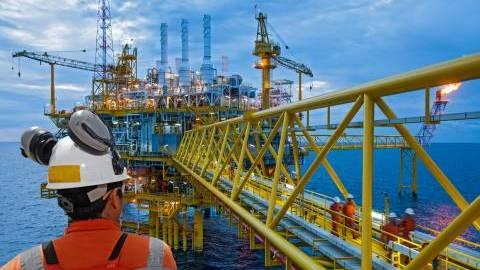(MENAFN- ING) Saudi Arabia trimmed the official selling price for January deliveries for all buyers on subdued oil demand and sufficient supplies
In this article
energy – Saudi slashes the official selling price for oil Metals – Vale expects stable iron ore output next year
Agriculture - ICO raises coffee consumption estimates

A worker inspects an offshore oil rig Energy – Saudi slashes the official selling price for oil
Oil prices continued to trade flat today after settling at a 5-month low of US$77.2/bbl yesterday. Saudi Arabia reduced its official selling price for most of the buyers for January deliveries due to subdued oil demand and softer oil prices. For European buyers, Saudi Aramco lowered the official selling price for all the crude oil grades by US$2/bbl for January deliveries. This follows a cut of around US$2.3/bbl in December 2023. Saudi's benchmark Arab Light grade is available for European buyers at a premium of US$2.9/bbl in Jan 2024 compared to a premium of US$7.2/bbl for Nov 2023 deliveries. For Asian buyers, the premium is set at US$3.5/bbl for Jan deliveries, down by around US$0.5/bbl compared to December prices. Premiums for the US buyers were also lowered by US$0.3/bbl for all the grades.
Meanwhile, the American Petroleum Institute (API) reported that the US crude oil inventories increased by 0.6MMbbls over the last week, in contrast to the market expectations of a drawdown of around 2.3MMbbls. Cushing crude oil stocks are reported to have increased by 4.3MMbbls. On the products side, API reported that gasoline and distillates inventories also increased by 2.8MMbbls and 1.9MMbbls, respectively, over the week ending 1 December. The more widely followed EIA report will be released later today.
Metals – Vale expects stable iron ore output next year
Vale SA expects the iron ore output to remain stable with a production guidance of 310mt-320mt in 2024, compared to the output estimates of 315mt for the current year. Among other major producers, Rio Tinto expects the Pilbara iron ore shipments to rise to 323mt-338mt in 2024, higher than the previous estimates of 320mt-335mt. The iron ore pellets and concentrates production is expected to range between 8mt-11, compared to the earlier estimates of 3mt-9. The stable output guidance from major producers would continue to support the upward rally of the raw material prices next year as well, given the expectations of recovering downstream demand.
Recent data from the China Iron and Steel Association (CISA) shows that steel inventories at major Chinese steel mills fell to 13mt (the lowest since January 2022) in late November, down 15.4% compared to mid-November. Crude steel production at major mills recovered by 2.4% from mid-November to 2.02mt/d in late November, as steel mills ramped up their production activities this month despite falling profits.
The latest LME COTR report released yesterday shows that investors increased net bullish positions for copper by 11,119 lots to 57,555 lots (the highest since the week ending on 1 September) as of last Friday following the recent mine supply disruptions. In contrast, money managers decreased net bullish bets in zinc by 5,324 lots after rising for four consecutive weeks to 32,587 lots. Net bullish bets for aluminium also fell marginally by 672 lots in the week ending on 1 December.
Agriculture - ICO raises coffee consumption estimates
In its latest report, the International Coffee Organization (ICO) expects global coffee consumption to rise 2.2% YoY to 177m bags for the 2023/24 season on expectations that consumers would switch to cheaper forms of coffee to combat rising prices. Global coffee demand fell 2% YoY in 2022/23. Global production estimates were also revised higher by 5.8% to 178m bags for the period mentioned above, leaving the global market balance in a supply surplus of 1m bags at the end of the season.
Weekly data from the European Commission shows that soft wheat exports for the season so far fell 18% YoY to reach 12 as of 3 December, down from 15 for the same period last year. The major destinations for these shipments were Morocco, Egypt, and Nigeria. European Union corn imports stand at 7.4mt, down 43% from a similar period a year ago. The EU has seen a recovery in its domestic corn output this season, reducing its reliance on imports.
MENAFN06122023000222011065ID1107548459
Author:
Ewa Manthey, Warren Patterson
*Content Disclaimer:
This publication has been prepared by ING solely for information purposes irrespective of a particular user's means, financial situation or investment objectives. The information does not constitute investment recommendation, and nor is it investment, legal or tax advice or an offer or solicitation to purchase or sell any financial instrument. Read more here: https://think.ing.com/about/disclaimer/
Legal Disclaimer:
MENAFN provides the information “as is” without warranty of any kind. We do not accept any responsibility or liability for the accuracy, content, images, videos, licenses, completeness, legality, or reliability of the information contained in this article. If you have any complaints or copyright issues related to this article, kindly contact the provider above.